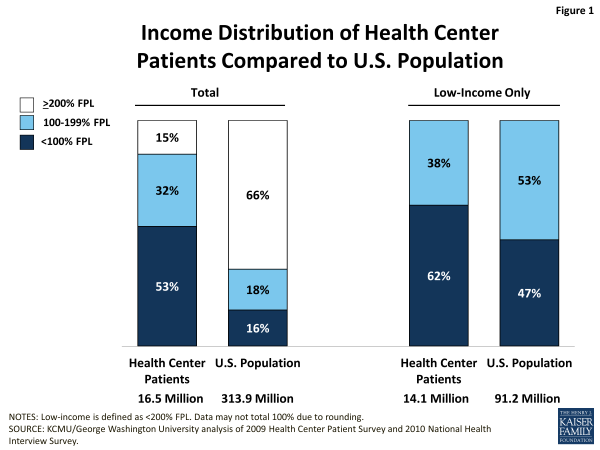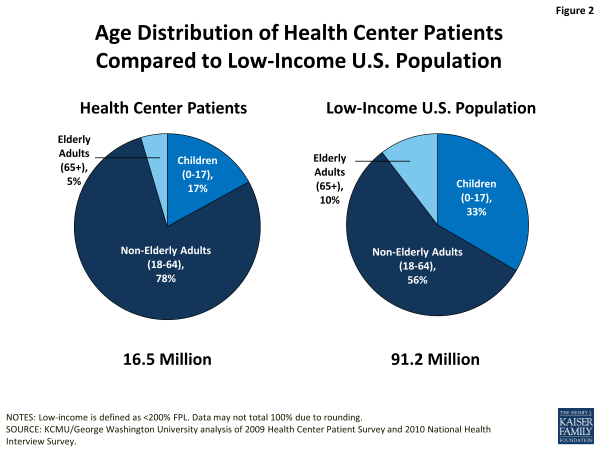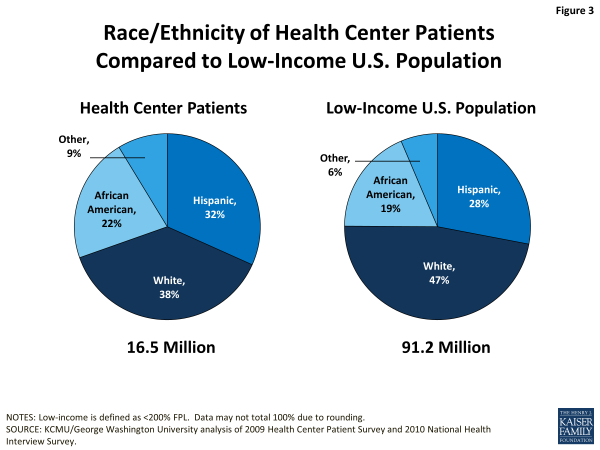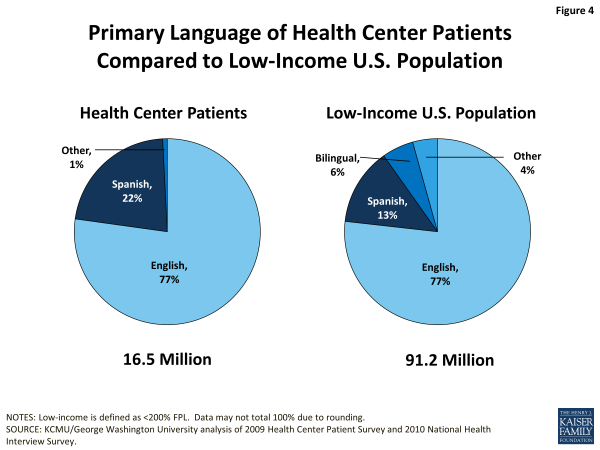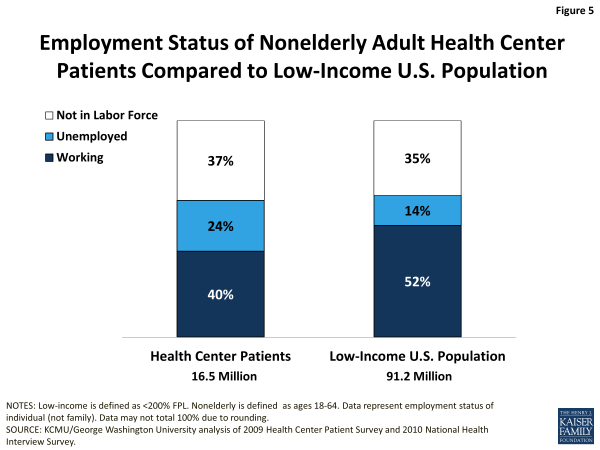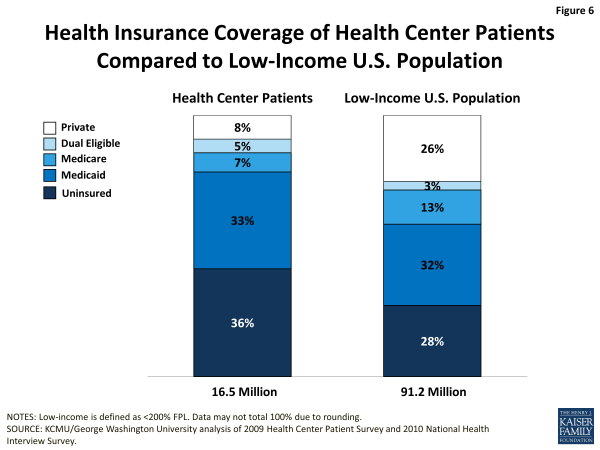A Profile of Community Health Center Patients: Implications for Policy
Demographic Characteristics
Community health center patients differ demographically from the total U.S. population and even from the low-income U.S. population. In part, the differences reflect health centers’ specific statutory mission to serve medically underserved communities and populations. In addition, some of the differences reported in this analysis may stem from the fact that the comparison presented here is between people who use health center services and a general low-income population that comprises both people who use and people who do not use health care (including care offered by health centers) in the survey period. Compared to the low-income population overall, health centers users are poorer, more racially and ethnically diverse, more likely to be working-age adults, and more likely to be unemployed and uninsured. Many of these factors relate to one another. For example, people of color experience disproportionately high rates of unemployment and low income,1 and low-income working-age adults are more likely than others to be uninsured.2
Income. Community health center patients are much more likely to be low-income than the U.S. population overall. More than half (53%) of individuals who obtain at least some of their care from health centers have income below the federal poverty level (FPL) ($11,490 for an individual and $23,550 for a family of four in 2013), and almost another third (32%) have income between 100% and 199% FPL (Figure 1, left panel). The remaining 15%, who have income equal to at least 200% FPL, tend to have very limited income as well. A recent analysis found that only 3% of CHC patients had incomes above 400%.3
The income distribution of the total U.S. population is much different. One-third of the population is below 200% FPL, divided about evenly between those below poverty and those between 100% and 199% FPL. Two-thirds have income at or above 200% FPL, and income levels in this group are not bunched near 200% FPL but are widely distributed.
Even within the population below 200% FPL, poverty is deeper among health center patients (Figure 1, right panel). More than six in ten low-income health center patients have income below the poverty level; by contrast, less than half (47%) of the low-income population overall is in this lowest income band. Our study population – all health center patients* – is overwhelmingly a low-income one. For that reason, and because low income is so strongly associated with certain other patient characteristics, we use the low-income U.S. population as our comparison group in the remainder of this analysis.
Age. Non-elderly adults (age 18-64) make up a much larger share of the health center patient population than of the low-income population overall. More than three-quarters of health center patients are working-age adults, compared to 56% of low-income people generally (Figure 2). Correspondingly, both children and people age 65 and older make up smaller shares of the health center population. Children represent 17% of health center patients, compared to 33% of low-income people overall; people age 65 and older represent 5% of health center patients, compared to 10% of all low-income people. The higher representation of working-age adults among health center patients suggests that low income non-elderly adults are especially reliant on health centers, compared to either low-income children or older adults. This finding likely reflects the significantly elevated uninsured rate among low-income working-age adults compared to other low-income age groups, a fact that requires them to depend more heavily on safety-net providers for care.4 It also may reflect the relatively high and unmet need for health care among a segment of the low-income adult population, which, when a health center exists in the community, leads them to seek care.
Race/ethnicity. Health center patients are more racially and ethnically diverse than the low-income population overall. They are more likely to be Hispanic, African-American, or a member of another racial or ethnic minority group. Patients are less likely to be White than the general low-income population (Figure 3). Thus, health centers play an important role in serving communities of color and helping narrow racial and ethnic disparities in health care. The relatively high representation of people of color among health center patients is likely a reflection of the strong correlations between race/ethnicity and low income, poorer health status, higher uninsured rates, and residence in medically underserved areas.
Language preference/primary language. Roughly three-quarters of both health center patients and the low-income population overall report English as their preferred or primary language. Over a fifth (22%) of health center patients say they prefer to speak Spanish over English or another language. Among the general low-income population, 13% say they speak only or mostly Spanish, while another 6% say they speak both English and Spanish. However, the two surveys ask about primary language differently, so the measures are not directly comparable between the two populations (Figure 4).
Employment status. Health center patients are more likely to be unemployed than low-income people overall. In 2009-2010, 24% of working-age adult health center patients were unemployed, compared to 14% of all low-income working-age adults (Figure 5). Given the adverse impact of joblessness on insurance coverage, the resulting difficulty that unemployed people face affording necessary health care, and the fact that health centers have traditionally served as a source of care for people who have trouble affording services, the higher unemployed rate among health center patients is not surprising.
Uninsured rate. Health center patients have higher uninsured rates than the general low-income population, in part because they are more likely to fall into the age range (nonelderly adults) in which the risk of being uninsured is highest. While 28% of all low-income people are uninsured, 36% of all health center patients are uninsured (Figure 6). Despite the fact that health center patients are more likely to be uninsured, the proportion of people with Medicaid coverage is almost the same – roughly one-third – among health center patients and the low-income population generally. Not unexpectedly, given the under-representation of patients age 65 and older among health center users (relative to the overall low-income population), the share of individuals with Medicare is relatively low among health center patients, compared to the overall low-income population (7% versus 13%). Also, even though working-age adults make up a substantially larger share of health center patients than of the broader low-income population, the rate of private coverage – largely, employer-sponsored insurance – is much lower among health center patients than among low-income people generally – 8% compared to 26%. Factors that may help to explain health center patients’ lower rate of private coverage include the deeper poverty of health center users, their worse health status (discussed below), and their higher rate of unemployment.
* Note: The total health center population is 16.5 million in all Figures in this brief. This total differs from the total of 20 million health center patients, cited in the Introduction. The difference is attributable to the use of different data sources (2009 Health Center Patient Survey and 2011 Uniform Data System Report (HRSA, 2012), respectively), and to the weighting methodology and additional adjustments to the data in the Health Center Patient Survey.

